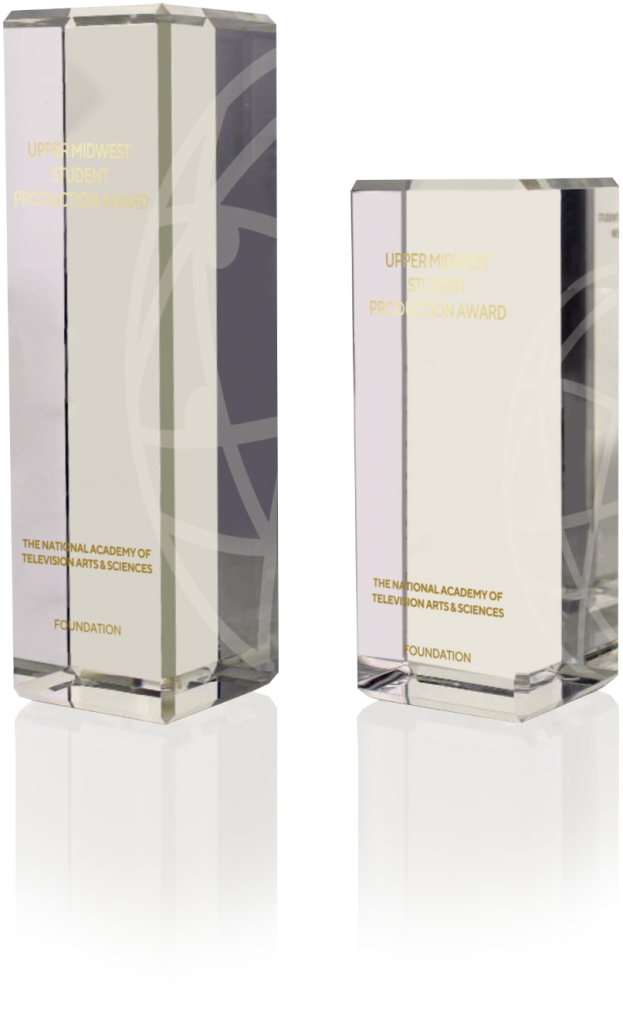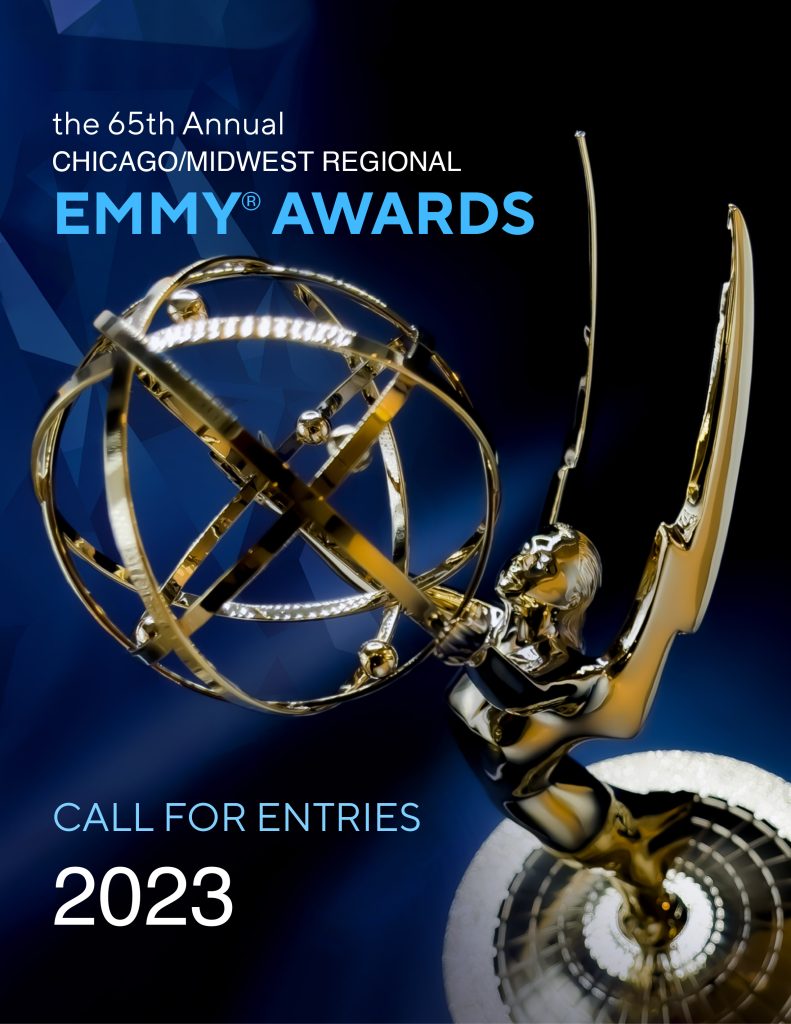65th Annual
CHICAGO/MIDWEST REGIONAL
EMMY® AWARDS
ELIGIBILITY PERIOD
June 1, 2022 – May 31, 2023
ENTRY DEADLINE
Friday, June 16, 2023
LATE ENTRY DEADLINE
Friday, June 23, 2023
Regional EMMY® NOMINATIONS PARTY
Regional EMMY® AWARDS
Ceremony
Saturday, November 11, 2023
Swissôtel, 323 E. Wacker, Chicago
ELIGIBILITY AREA
All broadcast, cable, broadband, cable / community / government access and video content providers (not close circuit or venue specific) located within the following Designated Market Areas (DMAs):
- Chicago, IL
- Rockford, IL
- Peoria/Bloomington, IL
- Milwaukee, WI
- Madison, WI
- Green Bay/Appleton, WI
- Wausau/Rhinelander, WI
- South Bend/Elkhart, IN
· DRM protected files from Microsoft (WMV) or the iTunes Store (M4V, MOV)
· WMV videos using the MSS2 video codec (for screencasting).
· Videos must be uploaded through Emmy® Express.
· The browser window must remain open while the file is being uploaded.
· If you don’t want to wait, you may close the browser window. The video will be processed in the background.
· NOTE: If you close the browser window, you must come back to approve the video upload.
· If you close the browser window during processing, you must come back later to approve it.
CHICAGO/MIDWEST SCHEDULE
Eligibility Period
June 1, 2022 – May 31, 2023
ENTRY DEADLINE
Friday, June 16, 2023, 11:59 pm
LATE ENTRY DEADLINE
Friday, June 23, 2023, 11:59 pm
add $30 to regular entry fee
DEADLINE

CHICAGO/MIDWEST Regional EMMY® Awards
Contest Rules
- Chicago, IL
- Rockford, IL
- Peoria/Bloomington, IL
- Milwaukee, WI
- Madison, WI
- Green Bay/Appleton, WI
- Wausau/Rhinelander, WI
- South Bend/Elkhart, IN
- Local station news coverage that may receive national exposure should be submitted to regional Emmy® Award competitions.
- A documentary film that has a limited theatrical release at film festivals (showing on 50 or fewer screens in the U.S. over a one-year period) before telecast or being made available online is eligible provided the program content is produced and intended for the regional or local audience. Documentary films with a theatrical debut more than one year prior to their television or streaming debut will not be eligible.
- Local content that later receives national distribution may be submitted to either a regional or a national awards competition, but not both.
- Local segments that are eligible to participate as entries in National Emmy® Award competitions (i.e. News & Doc) may compete in both regional and national awards competitions under prevailing rules.
REGIONAL vs. NATIONAL
In determining whether content distributed online, without geographic restriction, is more
appropriate for submission to a regional competition or a national one, entrants should
consider the following:
- Subject matter must be regionally or locally focused rather than national or global in scope
- If the content or program has been submitted into any of the NATAS national competitions in a previous or current awards cycle, it may no longer be submitted regionally.
- Company/individual has entered other similar content into NATAS national competitions.
- If the program or content has been promoted to/marketed to a national audience or produced in association with a national media brand, it may not be entered regionally.
- All promotional and craft-category submissions associated with the content must be submitted to the same competition.
Regional content that later receives national distribution may be submitted to either a Regional Awards competition or a relevant National Awards competition, subject to the following restrictions:
- Content may only be submitted to a single competition. A program submitted to a regional competition may not then be submitted to a national competition or another regional competition.
- All craft-category submissions associated with the content must be submitted to the same regional or national competition.
- Eligibility for a regional competition is determined by the date the production was first telecast or made available online or via VOD in a region.
- Eligibility for a national competition is determined by the date the production was first telecast or made available online or via VOD nationally.
-
In determining whether content distributed online, without geographic restriction, is more appropriate for submission to a regional competition or a national one, entrants should consider the following:
- Subject matter must be regionally or locally focused rather than national or global in scope.
- If the content or program has been submitted into any of the NATAS national competitions in a previous or current awards cycle, it may no longer be submitted regionally.
- Company/individual has entered other similar content into NATAS national competitions.
- If the program or content has been promoted to/marketed to a national audience or produced in association with a national media brand, it may not be entered regionally.
- All promotional and craft-category submissions associated with the content must be submitted to the same competition.
Regional content that later receives national distribution may be submitted to either a Regional Awards competition or a relevant National Awards competition, subject to the following restrictions:
- Content may only be submitted to a single competition. A program submitted to a regional competition may not then be submitted to a national competition or another regional competition.
- All craft-category submissions associated with the content must be submitted to the same regional or national competition.
- Eligibility for a regional competition is determined by the date the production was first telecast or made available online or via VOD in a region.
- Eligibility for a national competition is determined by the date the production was first telecast or made available online or via VOD nationally.
- Pornographic, violent, defamatory or offensive content.
- Previously distributed programs, series or related craft content which was distributed and met eligibility requirements during a previous awards year or another Emmy® competition.
- Program length commercials or infomercials.
- Closed circuit content or internal communications.
- No content produced or created for a regional or national Emmy® awards show may be submitted to an Emmy® awards contest. Related craft material is also ineligible.
- Motion picture content that premiered in general release to the public in theaters.
- Compilation reels, “clip shows” or “best of…” programs that were edited from original content.
- Any acquired foreign productions not originated in the United States.
An excerpt is defined as a continuous segment or section from longer content.
Unless noted in the category description, no more than three (3) excerpts may be used to bring longer content to the category’s specified entry time limit. For entries representing a program series, content must be included from multiple episodes of the series. A maximum of three (3) representative excerpts is permitted. One to two seconds of black, with no audio or slates, must be added to separate excerpts. If the awards committee determines the content of any excerpt is ineligible, the entire entry will be ruled ineligible. Removal of a commercial break between segments does not constitute a separate excerpt.
- No entry may be submitted to more than one Emmy® awards competition (Regional or National).
*Exception: Regional Emmy® recipients in the Breaking News and Investigative Report categories are eligible for submission to the National News & Documentary competition under prevailing rules. - Different episodes from the same program or series can only be entered in one Emmy® Awards competition
- Entrants are not allowed to separate content from individual craft achievement and submit in multiple Emmy® Awards competitions.
- If the Chapter deems content ineligible, craft submissions related to that content would also be ineligible.
- The first distribution of the entry is the primary determination of eligibility.
An investigative reporter is listed on a newscast entry. Under this double-dipping rule, a portion of the newscast content could be entered in Investigative Report, but the same reporter cannot be listed as a reporter since their name already appeared on the newscast entry in that specified role.
An investigative team does a three-part series within a newscast on gun control. Once the three parts have aired, and the same material re-purposed as a news or program special, the team would need to decide if they should enter the original series or the special, not both.
Your franchise is “This Week’s Health Advice.” The specific subject matter varies from week to week with topics such as Heart Health Awareness, Mary’s Battle with Lupus, Dietary Tips, The Best Yoga Studios in Springfield. You may submit each segment separately as individual entries based on the subject matter. Alternatively, you may submit all 5 segments in the Health category as a single entry representing the franchise. However, if you submit the franchise as a series entry, you may not submit any individual segments from the franchise elsewhere.
The National Academy of Television Arts & Sciences assumes no responsibility for the acts or omissions of those individuals or entities submitting entries pursuant to this notice. All submitting entities and/or individuals are advised to review submissions with respect to correct name credits and other information. NATAS shall accept all submissions that are not in conflict with any of its rules and regulations.
Once a Chapter’s award nominations are announced, there is a 10-calendar day grace period in which names, under extreme, special circumstances, can be added to a nominated entry. These requests should be authorized in writing to the Chapter from the person who submitted the entry or one of the entry nominees requesting this addition and detailing why this request should be granted. At a minimum, the appeal must include why the person was not originally listed on the entry AND what significant contributions that person made. An individual may petition the Chapter directly if the situation warrants. The Chapter’s Awards Committee will make the final decision and ruling.
Once the Emmy® Awards ceremony has concluded, NO individual names can be added to an awarded entry as an additional recipient, under any circumstances.
GLOSSARY OF TERMS
(also see: Craft Category)
A category for which there are two (2) areas of excellence being considered in the judging process: Creativity and Execution. These categories focus solely on the craft designated for each (photography, editing, talent, etc.) Our chapter’s craft categories are Categories 25 to 34. (also see: Content Category)
Maximum length allowed for the submitted entry video. This does not necessarily correspond with the original length of the video that was aired/distributed for viewing by the general public. Entry Time Limits vary among categories. Example: The length of a program when it originally aired was 60 minutes. You are entering that program in a category with an Entry Time Limit of 30 minutes. You must follow appropriate guidelines to shorten the entry video to 30 minutes or less.
Systematic, in-depth and original research and reporting of a single topic of interest, such as serious crime, political corruption, or corporate wrongdoing.
The Daytime, Children’s & Family, News & Documentary, Community Service, Sports and Technology & Engineering Emmy® Awards contests are held annually and open to all entrants whose work meets eligibility criteria.
- Serving as an “overseer” of the content, determining the overall tone, structure, look, sound, and mission of the content.
- Making strategic editorial decisions that have a significant impact on the resulting content.
- Identifying interview subjects and shoot locations.
- Scheduling interviews, shoots, and edits.
- Writing and/or approving scripts.
- Formulating ideas for graphics/animations and working with designers through completion.
- Working with editors to assure the content meets expectations and overseeing necessary changes.
The following are NOT considered to be Producers and are, therefore, not Emmy® statuette eligible. Note: An appropriate plaque or certificate may be purchased to recognize the support or contributions of these individuals.
- Clients, Sponsors, Underwriters, Funders, Distributors
- CEOs, Presidents, Vice Presidents, Company Owners, General Managers with no hands-on role in the video production
- News Directors and Executive Producers with no hands-on role in the video production
- Support staff or management with no hands-on role in the video production
- People or organizations that are the subject of the video, including interviewees
- People or organizations that provide resources (archives, photos, film, location access, etc.) for and/or during the production
COLLEGE
CALL FOR ENTRIES
EARLY DEADLINE
Friday, June 14, 2024
LATE ENTRY DEADLINE
Friday, June 21, 2024
Eligibility Period
June 1, 2023 - May 31, 2024
NOMINATIONS PARTY
SEPTEMBER 2024 TBA
AWARDS CEREMONY
NOVEMBER 2, 2024
STANDARD RULES
CHICAGO
PEORIA/BLOOMINGTON
ROCKFORD
SOUTH BEND / ELKHART
GREEN BAY / APPLETON
MADISON
MILWAUKEE
WAUSAU / RHINELANDER
CHICAGO
PEORIA/BLOOMINGTON
ROCKFORD
SOUTH BEND / ELKHART
GREEN BAY / APPLETON
MADISON
MILWAUKEE
WAUSAU / RHINELANDER
Entry and payment must be submitted online with the STUDENT EXPRESS system. The entry video is to be uploaded online as well (all directions online). Judging will also be done online. Entry forms can be printed out once you complete the entry process online. The email confirmation you receive should have a link listed for the printing of the entry form. We recommend that you print a copy of the entry form for your own records.
c/o Columbia College Chicago, Communication Dept
33 E. Ida B. Wells Drive, Ste. 535
Chicago, IL 60605

